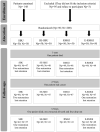Three-year evaluation of different adhesion strategies in non-carious cervical lesion restorations: a randomized clinical trial
- PMID: 34705986
- PMCID: PMC8523123
- DOI: 10.1590/1678-7757-2021-0192
Three-year evaluation of different adhesion strategies in non-carious cervical lesion restorations: a randomized clinical trial
Abstract
Objective: To evaluate non-carious cervical lesions (NCCLs) restored with different adhesion strategies.
Methodology: This is a prospective, randomized, double-blind, split-mouth study. An adhesive restorative system (Single Bond Universal/Filtek Z350XT - SBU) was evaluated both without and with selective enamel conditioning (E-SBU), resin-modified glass-ionomer cements (Vitremer; RMGIC), and ethylenediaminetetraacetic acid pretreatment (EDTA; E-RMGIC). In total, 200 restorations, placed in 50 patients, were evaluated at baseline and at a 3-year follow-up using the modified United States Public Health Service (USPHS) criteria. Data were analyzed using the two-proportion equality test, multinomial logistic regression, Wilcoxon test, and Kaplan-Meier survival curves.
Results: In total, 42 (84%) patients returned for the 3-year follow-up. SBU showed restoration losses statistically different from RMGIC. Retention was also statistically different in SBU between baseline and the 3-year follow-up. Marginal defects and surface texture were statistically significant for all groups in the period studied, except for the surface texture of SBU and the marginal integrity in E-RMGIC. We observed no statistically significant difference in wear, secondary caries, anatomical form, surface staining, and color over time. Recession degree was the only factor to influence retention rates. Cumulative survival (%) was 89, 98, 98, and 95.3, for SBU, SE-SBU, RMGIC, and E-RMGIC, respectively, without significant differences among them. There was a statistically significant difference between survival curves; however, multiple comparison procedures found no statistical differences.
Conclusion: Selective enamel etching affected the retention of non-carious cervical restorations. Adhesion using EDTA and resin-modified glass-ionomer cements delayed marginal defects over time. The degree of gingival recession influenced retention rates. Resin composite restorations showed initial marginal defects, and ionomer restorations, reduced surface luster. EDTA pre-treatment followed by resin-modified glass-ionomer cements may be a promising adhesion strategy for NCCL restorations.
Figures
References
-
- Walter C, Kress E, Gotz H, Taylor K, Willershausen I, Zampelis A. The anatomy of non-carious cervical lesions. Clin Oral Investig. 2014;18(1):139–146. doi: 10.1007/s00784-013-0960-0. - DOI - PubMed
- Walter C, Kress E, Gotz H, Taylor K, Willershausen I, Zampelis A. The anatomy of non-carious cervical lesions. Clin Oral Investig. 2014;18(1):139-46. doi: 10.1007/s00784-013-0960-0 - PubMed
-
- Oz FD, Meral E, Ergín E, Gurgan S. One-year evaluation of a new restorative glass ionomer cement for the restoration of non-carious cervical lesions in patients with systemic diseases: a randomized, clinical trial. J Appl Oral Sci. 2020;28:e20200311. doi: 10.1590/1678-7757-2020-0311. - DOI - PMC - PubMed
- Oz FD, Meral E, Ergín E, Gurgan S. One-year evaluation of a new restorative glass ionomer cement for the restoration of non-carious cervical lesions in patients with systemic diseases: a randomized, clinical trial. J Appl Oral Sci. 2020;28:e20200311. doi: 10.1590/1678-7757-2020-0311 - PMC - PubMed
-
- Shinohara MS, Carvalho PR, Neves Marcon L, Gonçalves DF, Ramos FS, Fagundes TC. Randomized clinical trial of different adhesion strategies in noncarious cervical lesion restorations: 1-year follow-up. Quintessence Int. 2020;51(5):352–363. doi: 10.3290/j.qi.a44367. - DOI - PubMed
- Shinohara MS, Carvalho PR, Neves Marcon L, Gonçalves DF, Ramos FS, Fagundes TC. Randomized clinical trial of different adhesion strategies in noncarious cervical lesion restorations: 1-year follow-up. Quintessence Int. 2020;51(5):352-63. doi: 10.3290/j.qi.a44367 - PubMed
-
- Bezerra IM, Brito AC, Sousa SA, Santiago BM, Cavalcanti YW, Almeida LF. Glass ionomer cements compared with composite resin in restoration of noncarious cervical lesions: a systematic review and meta-analysis. Heliyon. 2020;6(5):e03969. doi: 10.1016/j.heliyon.2020.e03969. - DOI - PMC - PubMed
- Bezerra IM, Brito AC, Sousa SA, Santiago BM, Cavalcanti YW, Almeida LF. Glass ionomer cements compared with composite resin in restoration of noncarious cervical lesions: a systematic review and meta-analysis. Heliyon. 2020;6(5):e03969. doi: 10.1016/j.heliyon.2020.e03969 - PMC - PubMed
-
- Ranjitha GR, Vikram R, Meena N, Vijayalakshmi L, Murthy CS. Clinical efficacy of universal adhesives for the restoration of noncarious cervical lesions: a randomized clinical trial. J Conserv Dent. 2020;23(3):227–232. doi: 10.4103/JCD.JCD_51_20. - DOI - PMC - PubMed
- Ranjitha GR, Vikram R, Meena N, Vijayalakshmi L, Murthy CS. Clinical efficacy of universal adhesives for the restoration of noncarious cervical lesions: a randomized clinical trial. J Conserv Dent. 2020;23(3):227-32. doi: 10.4103/JCD.JCD_51_20 - PMC - PubMed
Publication types
MeSH terms
Substances
LinkOut - more resources
Full Text Sources
Medical



